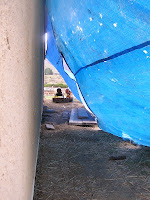This month has seen us working toward getting the house warm and liveable through winter. Jack Frost has been painting everything (as described by our youngest) for a few weeks and it has been pretty cold inside too! It was accentuated about 3 weeks ago when youngest woke in the middle

of the night requesting a cold drink: it was only when I got back to the bed that I realised the 'familiar' jingling in the cup was ice. Remains of his previous water had frozen during the night!
So thanks again go to wonderful friends who came around and helped put in a layer of newly delivered insulation. That has helped tremendously; it doesn't matter how insulating those walls are if there's nothing but tin between us and the stars it counts for nothing!!
The second part of getting the house warmed up has been a bit more of a mission. We needed to get the range up and running.

Firstly we had to instal a hearth as it is required by council; just in case that hearth rug goes slipping up under the range and spontaneously catches light with a random spark.... As we are going to need a few rocks James went on a shopping spree to a friends quarry; Cluden Quarry just out of Tarras. Not often I'm concerned about letting James loose with the finances, but those rocks are pretty tempting things: he did well though, showing great restraint! Then we had to use an angle grinder and a hammer to get shaping and prepping the chosen rock for its new life.


Next on the agenda was getting the floor level up around the kitchen and putting a clay cap on it temporarily so that we can keep the ground around the kitchen and stove free of flammables. Living in a not-so-finished straw bale house means bits of straw get in far too many places; some are just uncomfortable; some could be pretty risky under a lit stove! Great job by James building up with road metal then tamping down the Cardrona clay as a top. Makes life way less dustier too.
OK, so there are a few rules in life it always pays to remember; one of those is to read the instructions! In this case pertaining to the installation of one Shacklock 501 stove. This was one of the more efficient models Shacklock made and we read (too recently) with some dismay that in order for it to be 'more efficient' a number of things needed to be careful done during installation. So in our case, shifting it onto a bit of concrete just hadn't done the trick. These things were usually put into a purpose-built, tightly-fitting brick chimney place. Following the requirements to fill in around all the edges with a shingle or gravel substrate as an insulator and then plastering all the joins was therefore straightforward.
Thankfully, after much deliberation and chatting through options with friends we came up with a solution. Old (and free) concrete block were put down the one side and gravel packed between.
By coincidence a new neighbour who is interested in earth building came around one morning and offered to help - he knew of a source of free concrete blocks perfect for making a wall on the other side. So whilst his little girl and our children played very contentedly, our neighbour proceeded to lay the blocks using a lime-cement plaster. The result is just visible in the picture below.
The following day we called upon a couple of other friends to help us position the hearth stone. Some strops and a couple of bits of 4x2 made the job possible with one of us on each corner. My admiration for the skill of those Stonehenge builders is even more; 4 people with one heavy-enough stone over just a 15m stretch just doesn't even come close to what they achieved. Thanks though to B & H for helping make our rock heaving possible.
We've nearly done it but there's still a bit more to do before the momentous occasion that the stove gets lit. I've been pretty relaxed to date about the time things take, but that stove has been sitting asking to be lit for a
very long time - I can tell you I'm pretty keen to stoke her up...




































